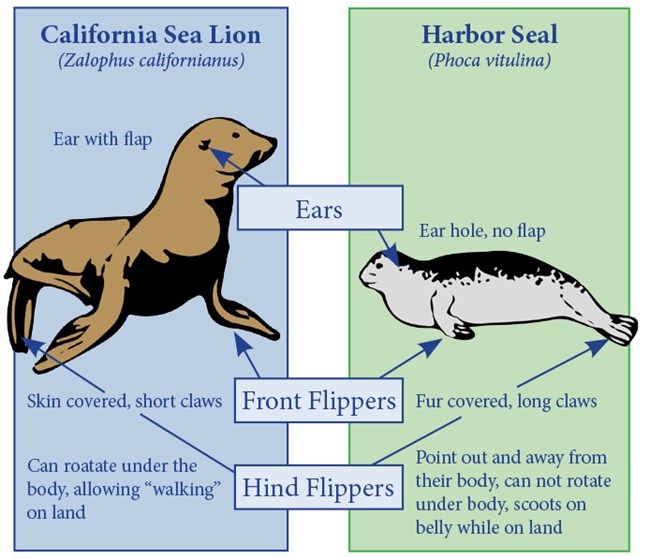What Are Pinnipeds?
The group of marine mammals consisting of seals, sea lions, and walruses is known as the Pinnipeds, (from "pinna" meaning "feather" + "pes" meaning "foot" = "feather-footed"). Pinnipeds divide their time between near shore terrestrial habitats and the ocean.
True seals are also known as earless seals, or simply "seals". In and around RNSP, there are two seal species to be found, the harbor seal (Phoca vitulina), and northern elephant seal (Mirounga angustirotris). Harbor seals are quite common and may be seen lounging on flat-topped near shore rocks, or hauled out sandy beaches, primarily around the Redwood Creek estuary. They are often seen bobbing in the surf, checking out the shoreline. Harbor seals come in a variety of colors from almost pure white to mottled gray or brown, but usually some form of color patterning is visible. Elephant seals, on the other hand, are uniformly tan colored all over, and seen only rarely within the parks. Usually there's only one subadult animal at a time hauled out on a sandy beach undergoing its annual molt. One must travel somewhere else along the California coast to see a spectacular adult male elephant seal, with its long proboscis, or nose, for which the species is named.
Fur seals and sea lions are also known as eared seals. In and around Redwood National and State Parks, the most commonly seen eared seal is the California sea lion (Zalophus californianus). These animals may be seen hauled out on off shore rocks, and occasionally on sandy beaches. Most of the California sea lions in RNSP are adult and subadult males that migrate north after the breeding season in southern California. California sea lions are the "trained seal" of marine parks and circuses. They are uniformly dark brown and vocalize with the notable sea lion "bark". The other resident eared seal is the Steller, or Northern, sea lion (Eumetopias jubata), a federally threatened species. There may be a small breeding colony of Stellers using near shore rocks in RNSP. Steller males are massive, the largest of the eared seals, weighing in at 1,200 lbs (0.5 metric ton) or greater. Females are much smaller. Steller sea lions have golden-colored fur with darker extremities, and instead of the "bark" of the California sea lion, Stellers vocalize by growling or "bellowing".

